Terrorism’s Impact on the Hospitality & Tourism Industry in Kenya
VerifiedAdded on 2023/06/04
|10
|2323
|461
AI Summary
This report analyzes the impact of terrorism on the hospitality and tourism industry in Kenya, with a focus on the 2013 Westgate Shopping Mall attack. The report provides policy recommendations for counter-terrorism measures and highlights the stakeholders involved in improving the industry. The report also discusses the overview of the tourism and hospitality industry in Kenya and the critical analysis of the impact of terrorism on the industry.
Contribute Materials
Your contribution can guide someone’s learning journey. Share your
documents today.
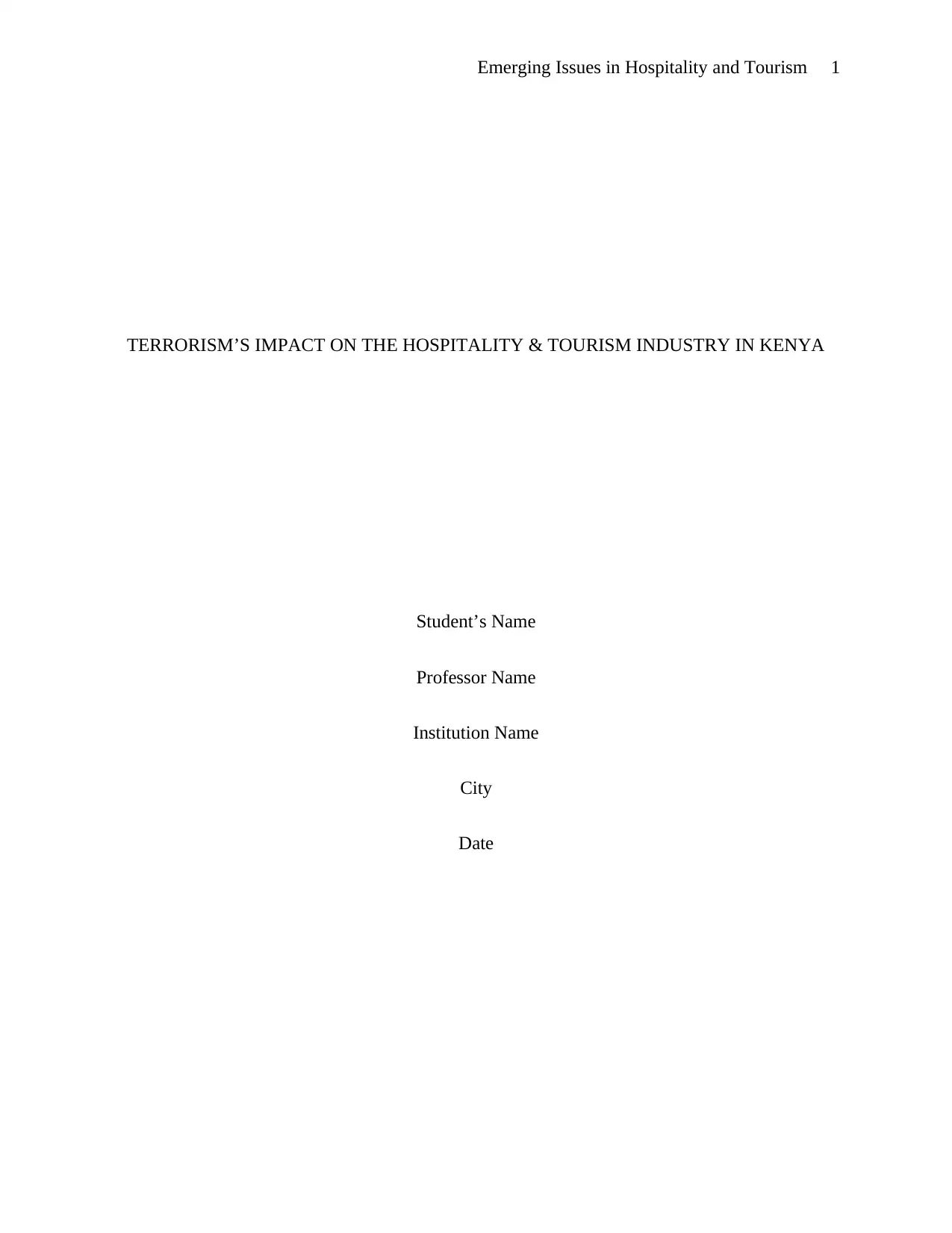
Emerging Issues in Hospitality and Tourism 1
TERRORISM’S IMPACT ON THE HOSPITALITY & TOURISM INDUSTRY IN KENYA
Student’s Name
Professor Name
Institution Name
City
Date
TERRORISM’S IMPACT ON THE HOSPITALITY & TOURISM INDUSTRY IN KENYA
Student’s Name
Professor Name
Institution Name
City
Date
Secure Best Marks with AI Grader
Need help grading? Try our AI Grader for instant feedback on your assignments.
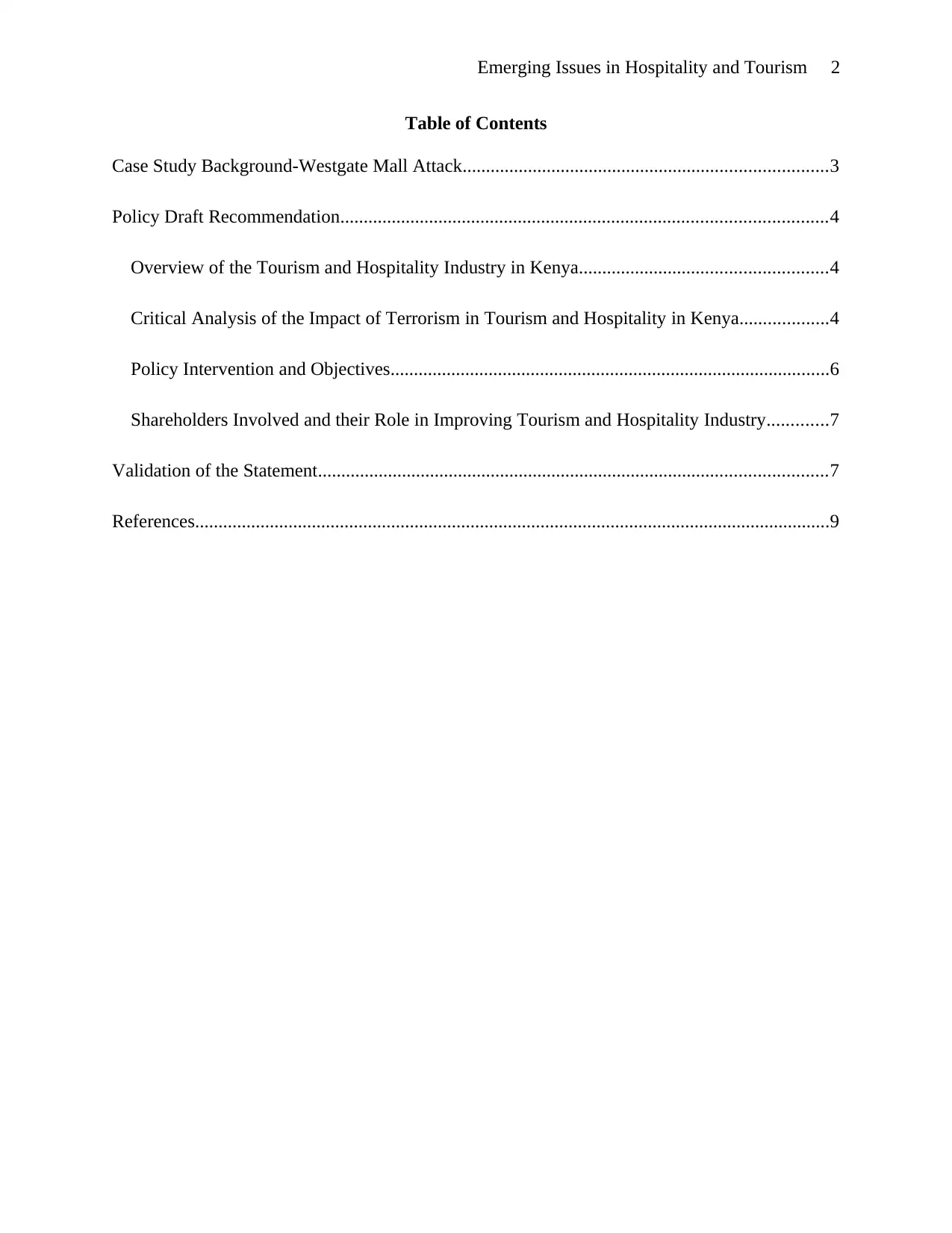
Emerging Issues in Hospitality and Tourism 2
Table of Contents
Case Study Background-Westgate Mall Attack..............................................................................3
Policy Draft Recommendation........................................................................................................4
Overview of the Tourism and Hospitality Industry in Kenya.....................................................4
Critical Analysis of the Impact of Terrorism in Tourism and Hospitality in Kenya...................4
Policy Intervention and Objectives..............................................................................................6
Shareholders Involved and their Role in Improving Tourism and Hospitality Industry.............7
Validation of the Statement.............................................................................................................7
References........................................................................................................................................9
Table of Contents
Case Study Background-Westgate Mall Attack..............................................................................3
Policy Draft Recommendation........................................................................................................4
Overview of the Tourism and Hospitality Industry in Kenya.....................................................4
Critical Analysis of the Impact of Terrorism in Tourism and Hospitality in Kenya...................4
Policy Intervention and Objectives..............................................................................................6
Shareholders Involved and their Role in Improving Tourism and Hospitality Industry.............7
Validation of the Statement.............................................................................................................7
References........................................................................................................................................9
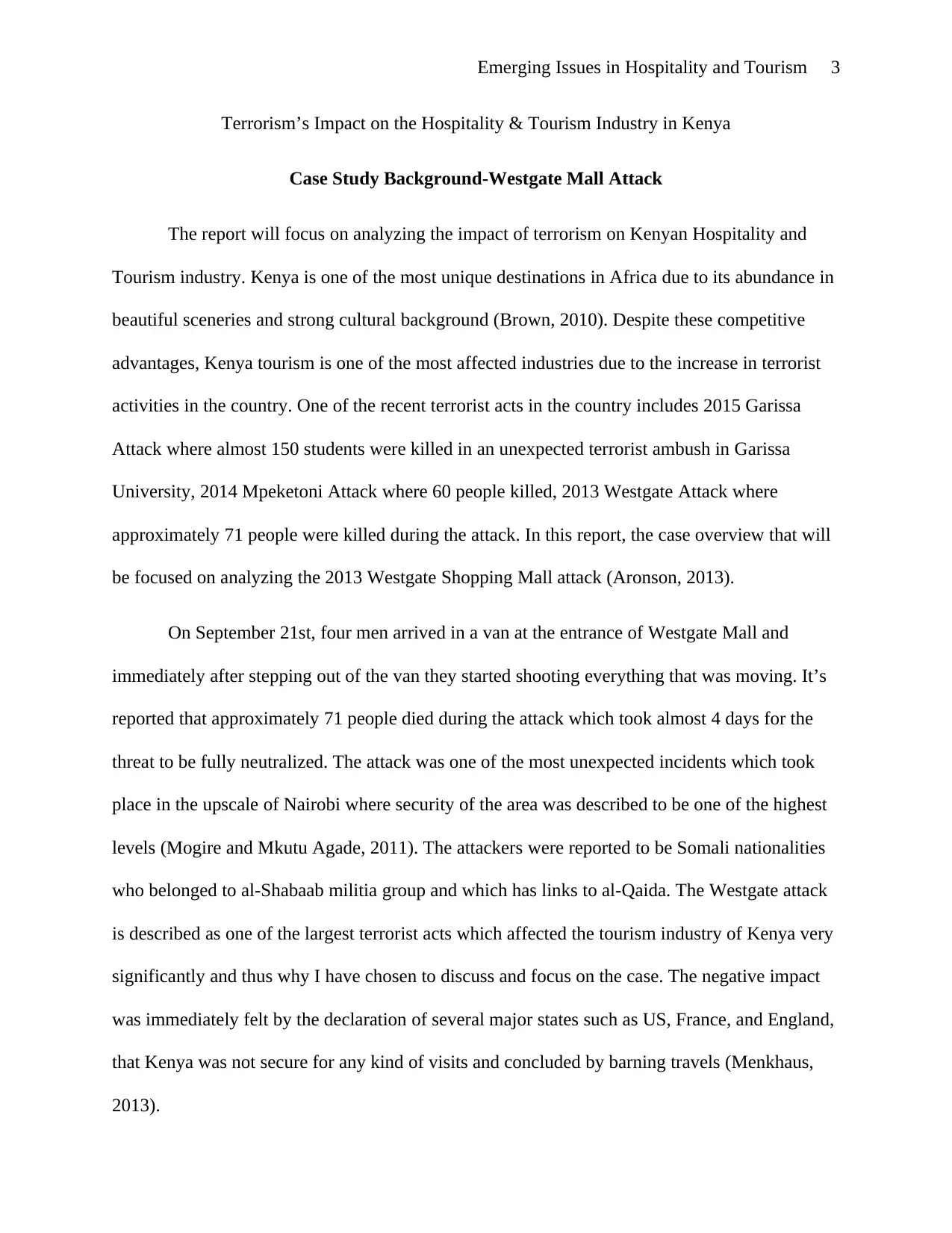
Emerging Issues in Hospitality and Tourism 3
Terrorism’s Impact on the Hospitality & Tourism Industry in Kenya
Case Study Background-Westgate Mall Attack
The report will focus on analyzing the impact of terrorism on Kenyan Hospitality and
Tourism industry. Kenya is one of the most unique destinations in Africa due to its abundance in
beautiful sceneries and strong cultural background (Brown, 2010). Despite these competitive
advantages, Kenya tourism is one of the most affected industries due to the increase in terrorist
activities in the country. One of the recent terrorist acts in the country includes 2015 Garissa
Attack where almost 150 students were killed in an unexpected terrorist ambush in Garissa
University, 2014 Mpeketoni Attack where 60 people killed, 2013 Westgate Attack where
approximately 71 people were killed during the attack. In this report, the case overview that will
be focused on analyzing the 2013 Westgate Shopping Mall attack (Aronson, 2013).
On September 21st, four men arrived in a van at the entrance of Westgate Mall and
immediately after stepping out of the van they started shooting everything that was moving. It’s
reported that approximately 71 people died during the attack which took almost 4 days for the
threat to be fully neutralized. The attack was one of the most unexpected incidents which took
place in the upscale of Nairobi where security of the area was described to be one of the highest
levels (Mogire and Mkutu Agade, 2011). The attackers were reported to be Somali nationalities
who belonged to al-Shabaab militia group and which has links to al-Qaida. The Westgate attack
is described as one of the largest terrorist acts which affected the tourism industry of Kenya very
significantly and thus why I have chosen to discuss and focus on the case. The negative impact
was immediately felt by the declaration of several major states such as US, France, and England,
that Kenya was not secure for any kind of visits and concluded by barning travels (Menkhaus,
2013).
Terrorism’s Impact on the Hospitality & Tourism Industry in Kenya
Case Study Background-Westgate Mall Attack
The report will focus on analyzing the impact of terrorism on Kenyan Hospitality and
Tourism industry. Kenya is one of the most unique destinations in Africa due to its abundance in
beautiful sceneries and strong cultural background (Brown, 2010). Despite these competitive
advantages, Kenya tourism is one of the most affected industries due to the increase in terrorist
activities in the country. One of the recent terrorist acts in the country includes 2015 Garissa
Attack where almost 150 students were killed in an unexpected terrorist ambush in Garissa
University, 2014 Mpeketoni Attack where 60 people killed, 2013 Westgate Attack where
approximately 71 people were killed during the attack. In this report, the case overview that will
be focused on analyzing the 2013 Westgate Shopping Mall attack (Aronson, 2013).
On September 21st, four men arrived in a van at the entrance of Westgate Mall and
immediately after stepping out of the van they started shooting everything that was moving. It’s
reported that approximately 71 people died during the attack which took almost 4 days for the
threat to be fully neutralized. The attack was one of the most unexpected incidents which took
place in the upscale of Nairobi where security of the area was described to be one of the highest
levels (Mogire and Mkutu Agade, 2011). The attackers were reported to be Somali nationalities
who belonged to al-Shabaab militia group and which has links to al-Qaida. The Westgate attack
is described as one of the largest terrorist acts which affected the tourism industry of Kenya very
significantly and thus why I have chosen to discuss and focus on the case. The negative impact
was immediately felt by the declaration of several major states such as US, France, and England,
that Kenya was not secure for any kind of visits and concluded by barning travels (Menkhaus,
2013).
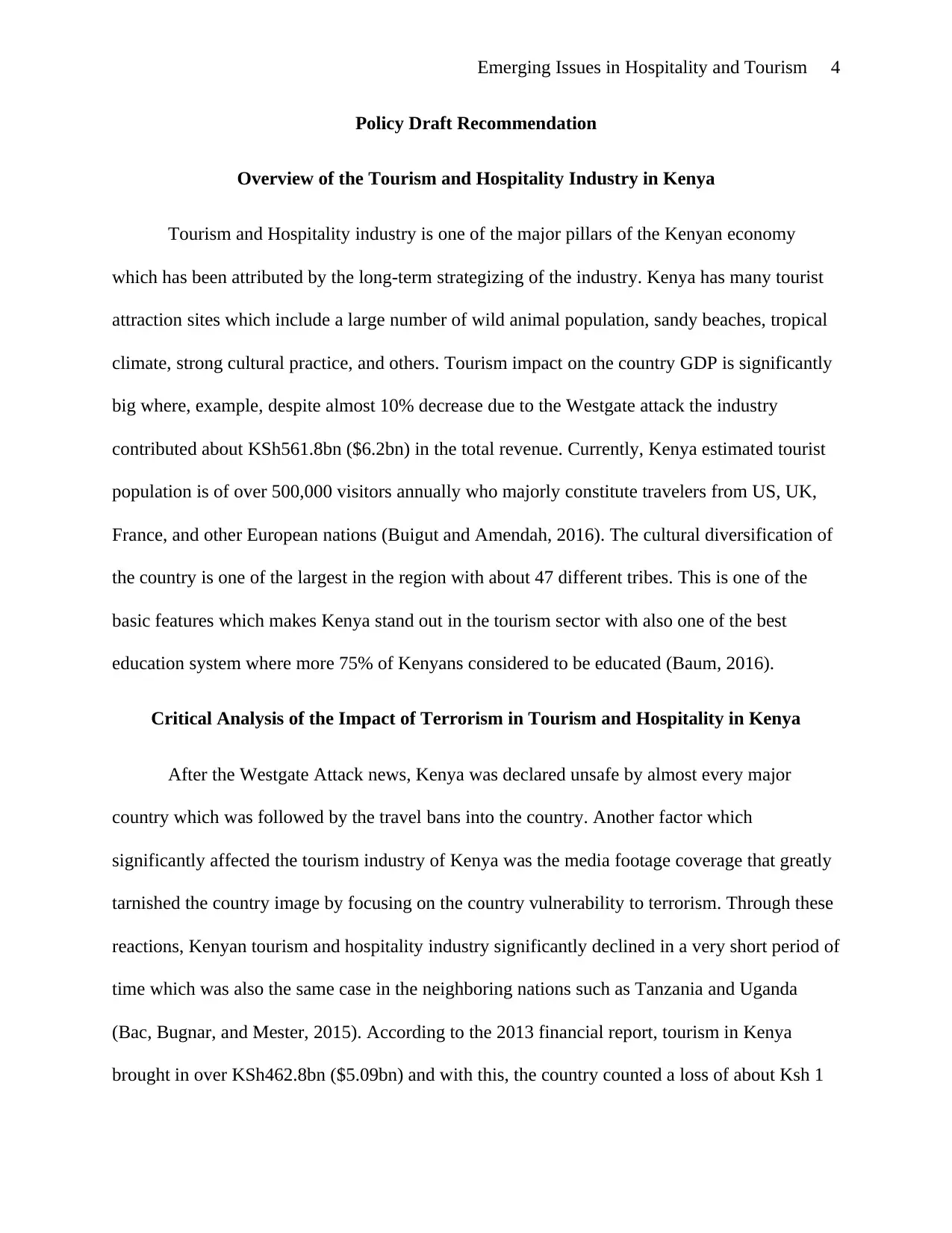
Emerging Issues in Hospitality and Tourism 4
Policy Draft Recommendation
Overview of the Tourism and Hospitality Industry in Kenya
Tourism and Hospitality industry is one of the major pillars of the Kenyan economy
which has been attributed by the long-term strategizing of the industry. Kenya has many tourist
attraction sites which include a large number of wild animal population, sandy beaches, tropical
climate, strong cultural practice, and others. Tourism impact on the country GDP is significantly
big where, example, despite almost 10% decrease due to the Westgate attack the industry
contributed about KSh561.8bn ($6.2bn) in the total revenue. Currently, Kenya estimated tourist
population is of over 500,000 visitors annually who majorly constitute travelers from US, UK,
France, and other European nations (Buigut and Amendah, 2016). The cultural diversification of
the country is one of the largest in the region with about 47 different tribes. This is one of the
basic features which makes Kenya stand out in the tourism sector with also one of the best
education system where more 75% of Kenyans considered to be educated (Baum, 2016).
Critical Analysis of the Impact of Terrorism in Tourism and Hospitality in Kenya
After the Westgate Attack news, Kenya was declared unsafe by almost every major
country which was followed by the travel bans into the country. Another factor which
significantly affected the tourism industry of Kenya was the media footage coverage that greatly
tarnished the country image by focusing on the country vulnerability to terrorism. Through these
reactions, Kenyan tourism and hospitality industry significantly declined in a very short period of
time which was also the same case in the neighboring nations such as Tanzania and Uganda
(Bac, Bugnar, and Mester, 2015). According to the 2013 financial report, tourism in Kenya
brought in over KSh462.8bn ($5.09bn) and with this, the country counted a loss of about Ksh 1
Policy Draft Recommendation
Overview of the Tourism and Hospitality Industry in Kenya
Tourism and Hospitality industry is one of the major pillars of the Kenyan economy
which has been attributed by the long-term strategizing of the industry. Kenya has many tourist
attraction sites which include a large number of wild animal population, sandy beaches, tropical
climate, strong cultural practice, and others. Tourism impact on the country GDP is significantly
big where, example, despite almost 10% decrease due to the Westgate attack the industry
contributed about KSh561.8bn ($6.2bn) in the total revenue. Currently, Kenya estimated tourist
population is of over 500,000 visitors annually who majorly constitute travelers from US, UK,
France, and other European nations (Buigut and Amendah, 2016). The cultural diversification of
the country is one of the largest in the region with about 47 different tribes. This is one of the
basic features which makes Kenya stand out in the tourism sector with also one of the best
education system where more 75% of Kenyans considered to be educated (Baum, 2016).
Critical Analysis of the Impact of Terrorism in Tourism and Hospitality in Kenya
After the Westgate Attack news, Kenya was declared unsafe by almost every major
country which was followed by the travel bans into the country. Another factor which
significantly affected the tourism industry of Kenya was the media footage coverage that greatly
tarnished the country image by focusing on the country vulnerability to terrorism. Through these
reactions, Kenyan tourism and hospitality industry significantly declined in a very short period of
time which was also the same case in the neighboring nations such as Tanzania and Uganda
(Bac, Bugnar, and Mester, 2015). According to the 2013 financial report, tourism in Kenya
brought in over KSh462.8bn ($5.09bn) and with this, the country counted a loss of about Ksh 1
Secure Best Marks with AI Grader
Need help grading? Try our AI Grader for instant feedback on your assignments.
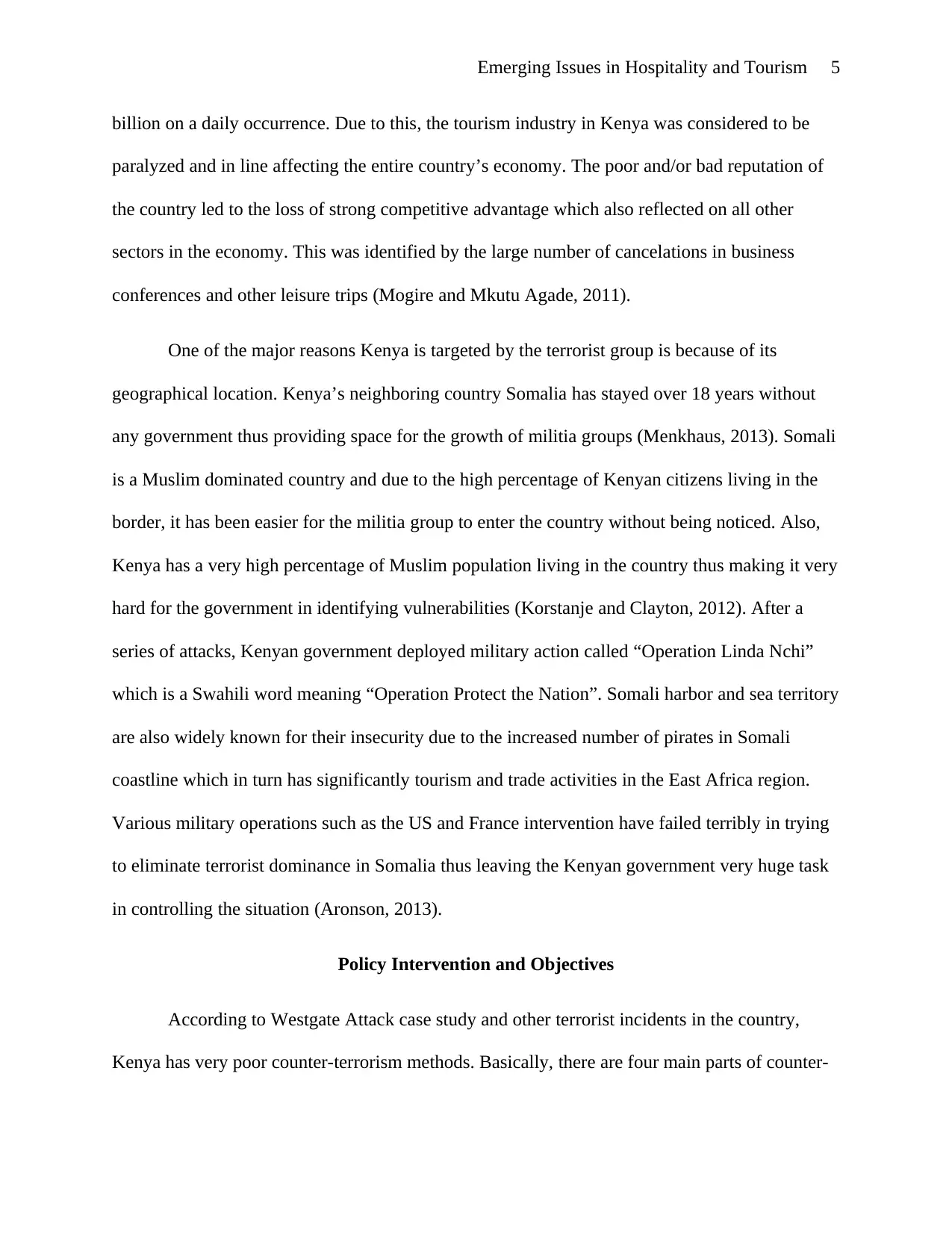
Emerging Issues in Hospitality and Tourism 5
billion on a daily occurrence. Due to this, the tourism industry in Kenya was considered to be
paralyzed and in line affecting the entire country’s economy. The poor and/or bad reputation of
the country led to the loss of strong competitive advantage which also reflected on all other
sectors in the economy. This was identified by the large number of cancelations in business
conferences and other leisure trips (Mogire and Mkutu Agade, 2011).
One of the major reasons Kenya is targeted by the terrorist group is because of its
geographical location. Kenya’s neighboring country Somalia has stayed over 18 years without
any government thus providing space for the growth of militia groups (Menkhaus, 2013). Somali
is a Muslim dominated country and due to the high percentage of Kenyan citizens living in the
border, it has been easier for the militia group to enter the country without being noticed. Also,
Kenya has a very high percentage of Muslim population living in the country thus making it very
hard for the government in identifying vulnerabilities (Korstanje and Clayton, 2012). After a
series of attacks, Kenyan government deployed military action called “Operation Linda Nchi”
which is a Swahili word meaning “Operation Protect the Nation”. Somali harbor and sea territory
are also widely known for their insecurity due to the increased number of pirates in Somali
coastline which in turn has significantly tourism and trade activities in the East Africa region.
Various military operations such as the US and France intervention have failed terribly in trying
to eliminate terrorist dominance in Somalia thus leaving the Kenyan government very huge task
in controlling the situation (Aronson, 2013).
Policy Intervention and Objectives
According to Westgate Attack case study and other terrorist incidents in the country,
Kenya has very poor counter-terrorism methods. Basically, there are four main parts of counter-
billion on a daily occurrence. Due to this, the tourism industry in Kenya was considered to be
paralyzed and in line affecting the entire country’s economy. The poor and/or bad reputation of
the country led to the loss of strong competitive advantage which also reflected on all other
sectors in the economy. This was identified by the large number of cancelations in business
conferences and other leisure trips (Mogire and Mkutu Agade, 2011).
One of the major reasons Kenya is targeted by the terrorist group is because of its
geographical location. Kenya’s neighboring country Somalia has stayed over 18 years without
any government thus providing space for the growth of militia groups (Menkhaus, 2013). Somali
is a Muslim dominated country and due to the high percentage of Kenyan citizens living in the
border, it has been easier for the militia group to enter the country without being noticed. Also,
Kenya has a very high percentage of Muslim population living in the country thus making it very
hard for the government in identifying vulnerabilities (Korstanje and Clayton, 2012). After a
series of attacks, Kenyan government deployed military action called “Operation Linda Nchi”
which is a Swahili word meaning “Operation Protect the Nation”. Somali harbor and sea territory
are also widely known for their insecurity due to the increased number of pirates in Somali
coastline which in turn has significantly tourism and trade activities in the East Africa region.
Various military operations such as the US and France intervention have failed terribly in trying
to eliminate terrorist dominance in Somalia thus leaving the Kenyan government very huge task
in controlling the situation (Aronson, 2013).
Policy Intervention and Objectives
According to Westgate Attack case study and other terrorist incidents in the country,
Kenya has very poor counter-terrorism methods. Basically, there are four main parts of counter-
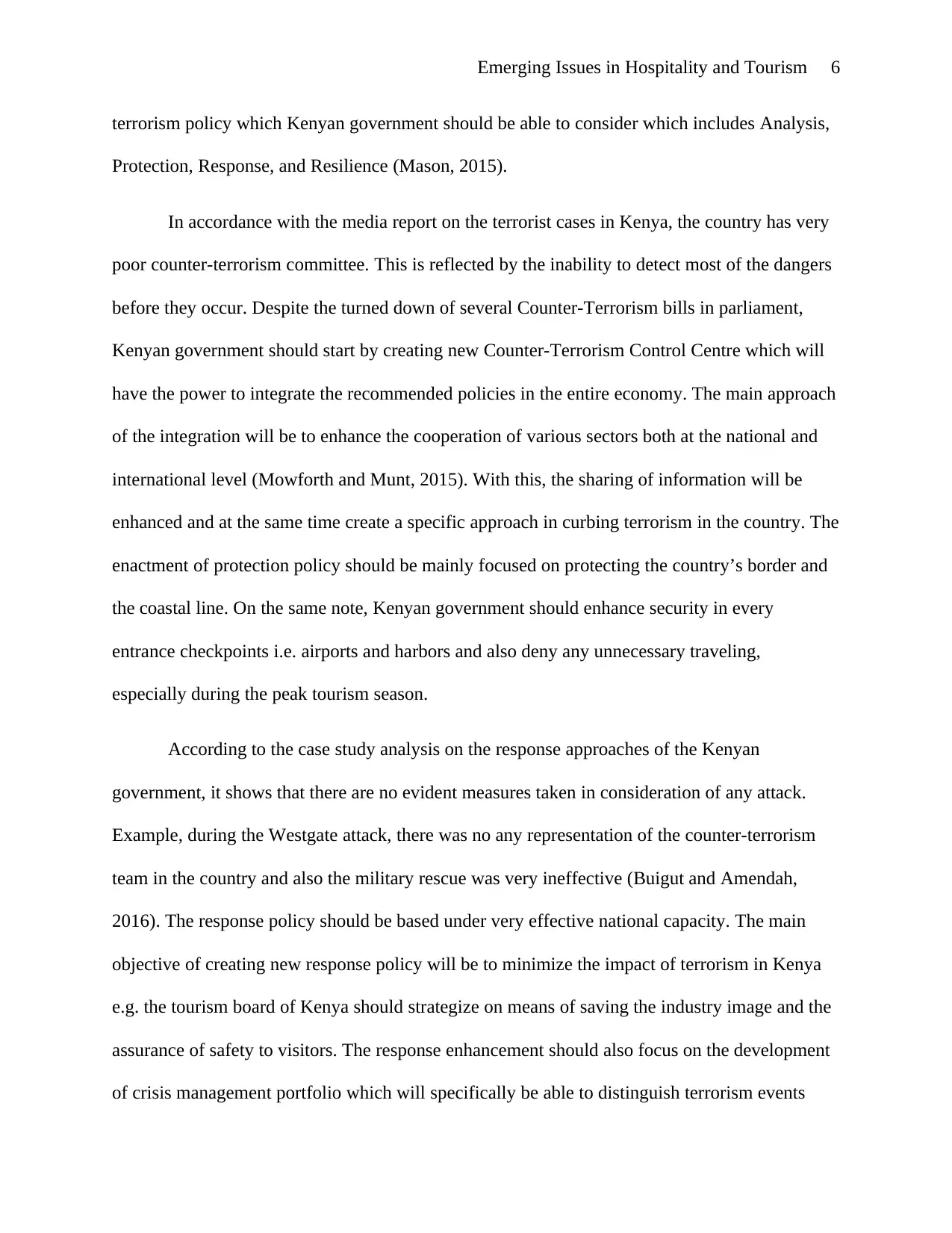
Emerging Issues in Hospitality and Tourism 6
terrorism policy which Kenyan government should be able to consider which includes Analysis,
Protection, Response, and Resilience (Mason, 2015).
In accordance with the media report on the terrorist cases in Kenya, the country has very
poor counter-terrorism committee. This is reflected by the inability to detect most of the dangers
before they occur. Despite the turned down of several Counter-Terrorism bills in parliament,
Kenyan government should start by creating new Counter-Terrorism Control Centre which will
have the power to integrate the recommended policies in the entire economy. The main approach
of the integration will be to enhance the cooperation of various sectors both at the national and
international level (Mowforth and Munt, 2015). With this, the sharing of information will be
enhanced and at the same time create a specific approach in curbing terrorism in the country. The
enactment of protection policy should be mainly focused on protecting the country’s border and
the coastal line. On the same note, Kenyan government should enhance security in every
entrance checkpoints i.e. airports and harbors and also deny any unnecessary traveling,
especially during the peak tourism season.
According to the case study analysis on the response approaches of the Kenyan
government, it shows that there are no evident measures taken in consideration of any attack.
Example, during the Westgate attack, there was no any representation of the counter-terrorism
team in the country and also the military rescue was very ineffective (Buigut and Amendah,
2016). The response policy should be based under very effective national capacity. The main
objective of creating new response policy will be to minimize the impact of terrorism in Kenya
e.g. the tourism board of Kenya should strategize on means of saving the industry image and the
assurance of safety to visitors. The response enhancement should also focus on the development
of crisis management portfolio which will specifically be able to distinguish terrorism events
terrorism policy which Kenyan government should be able to consider which includes Analysis,
Protection, Response, and Resilience (Mason, 2015).
In accordance with the media report on the terrorist cases in Kenya, the country has very
poor counter-terrorism committee. This is reflected by the inability to detect most of the dangers
before they occur. Despite the turned down of several Counter-Terrorism bills in parliament,
Kenyan government should start by creating new Counter-Terrorism Control Centre which will
have the power to integrate the recommended policies in the entire economy. The main approach
of the integration will be to enhance the cooperation of various sectors both at the national and
international level (Mowforth and Munt, 2015). With this, the sharing of information will be
enhanced and at the same time create a specific approach in curbing terrorism in the country. The
enactment of protection policy should be mainly focused on protecting the country’s border and
the coastal line. On the same note, Kenyan government should enhance security in every
entrance checkpoints i.e. airports and harbors and also deny any unnecessary traveling,
especially during the peak tourism season.
According to the case study analysis on the response approaches of the Kenyan
government, it shows that there are no evident measures taken in consideration of any attack.
Example, during the Westgate attack, there was no any representation of the counter-terrorism
team in the country and also the military rescue was very ineffective (Buigut and Amendah,
2016). The response policy should be based under very effective national capacity. The main
objective of creating new response policy will be to minimize the impact of terrorism in Kenya
e.g. the tourism board of Kenya should strategize on means of saving the industry image and the
assurance of safety to visitors. The response enhancement should also focus on the development
of crisis management portfolio which will specifically be able to distinguish terrorism events
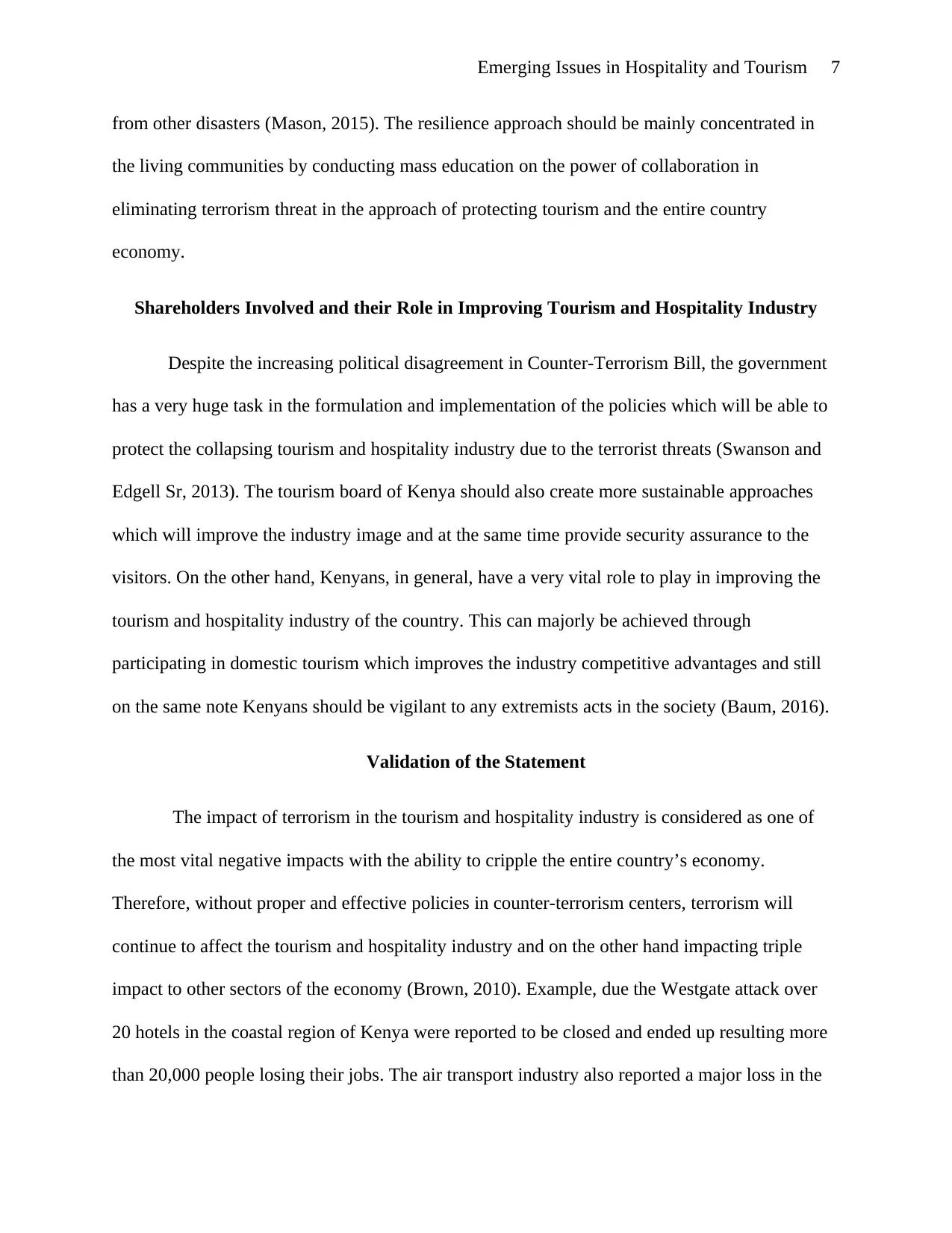
Emerging Issues in Hospitality and Tourism 7
from other disasters (Mason, 2015). The resilience approach should be mainly concentrated in
the living communities by conducting mass education on the power of collaboration in
eliminating terrorism threat in the approach of protecting tourism and the entire country
economy.
Shareholders Involved and their Role in Improving Tourism and Hospitality Industry
Despite the increasing political disagreement in Counter-Terrorism Bill, the government
has a very huge task in the formulation and implementation of the policies which will be able to
protect the collapsing tourism and hospitality industry due to the terrorist threats (Swanson and
Edgell Sr, 2013). The tourism board of Kenya should also create more sustainable approaches
which will improve the industry image and at the same time provide security assurance to the
visitors. On the other hand, Kenyans, in general, have a very vital role to play in improving the
tourism and hospitality industry of the country. This can majorly be achieved through
participating in domestic tourism which improves the industry competitive advantages and still
on the same note Kenyans should be vigilant to any extremists acts in the society (Baum, 2016).
Validation of the Statement
The impact of terrorism in the tourism and hospitality industry is considered as one of
the most vital negative impacts with the ability to cripple the entire country’s economy.
Therefore, without proper and effective policies in counter-terrorism centers, terrorism will
continue to affect the tourism and hospitality industry and on the other hand impacting triple
impact to other sectors of the economy (Brown, 2010). Example, due the Westgate attack over
20 hotels in the coastal region of Kenya were reported to be closed and ended up resulting more
than 20,000 people losing their jobs. The air transport industry also reported a major loss in the
from other disasters (Mason, 2015). The resilience approach should be mainly concentrated in
the living communities by conducting mass education on the power of collaboration in
eliminating terrorism threat in the approach of protecting tourism and the entire country
economy.
Shareholders Involved and their Role in Improving Tourism and Hospitality Industry
Despite the increasing political disagreement in Counter-Terrorism Bill, the government
has a very huge task in the formulation and implementation of the policies which will be able to
protect the collapsing tourism and hospitality industry due to the terrorist threats (Swanson and
Edgell Sr, 2013). The tourism board of Kenya should also create more sustainable approaches
which will improve the industry image and at the same time provide security assurance to the
visitors. On the other hand, Kenyans, in general, have a very vital role to play in improving the
tourism and hospitality industry of the country. This can majorly be achieved through
participating in domestic tourism which improves the industry competitive advantages and still
on the same note Kenyans should be vigilant to any extremists acts in the society (Baum, 2016).
Validation of the Statement
The impact of terrorism in the tourism and hospitality industry is considered as one of
the most vital negative impacts with the ability to cripple the entire country’s economy.
Therefore, without proper and effective policies in counter-terrorism centers, terrorism will
continue to affect the tourism and hospitality industry and on the other hand impacting triple
impact to other sectors of the economy (Brown, 2010). Example, due the Westgate attack over
20 hotels in the coastal region of Kenya were reported to be closed and ended up resulting more
than 20,000 people losing their jobs. The air transport industry also reported a major loss in the
Paraphrase This Document
Need a fresh take? Get an instant paraphrase of this document with our AI Paraphraser
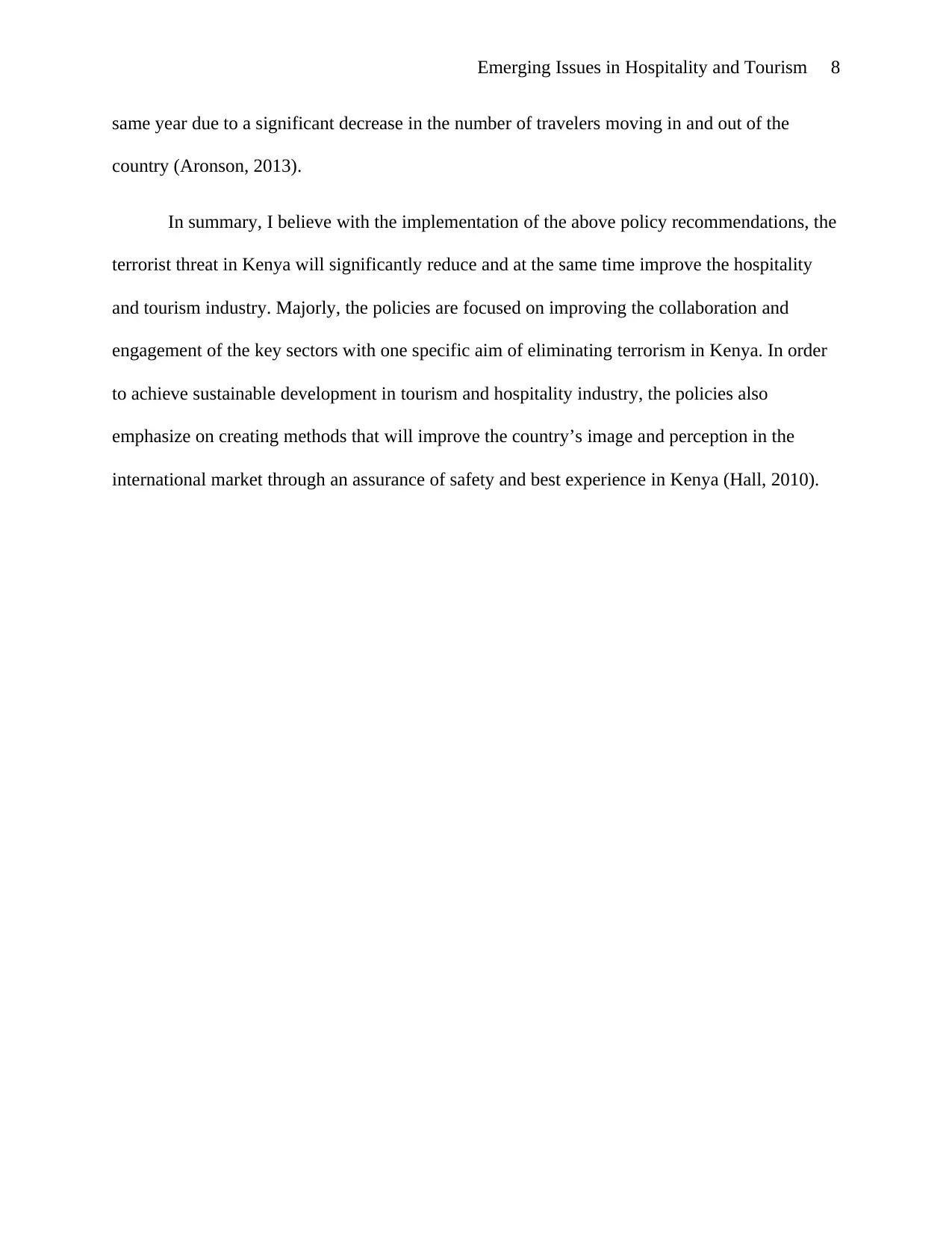
Emerging Issues in Hospitality and Tourism 8
same year due to a significant decrease in the number of travelers moving in and out of the
country (Aronson, 2013).
In summary, I believe with the implementation of the above policy recommendations, the
terrorist threat in Kenya will significantly reduce and at the same time improve the hospitality
and tourism industry. Majorly, the policies are focused on improving the collaboration and
engagement of the key sectors with one specific aim of eliminating terrorism in Kenya. In order
to achieve sustainable development in tourism and hospitality industry, the policies also
emphasize on creating methods that will improve the country’s image and perception in the
international market through an assurance of safety and best experience in Kenya (Hall, 2010).
same year due to a significant decrease in the number of travelers moving in and out of the
country (Aronson, 2013).
In summary, I believe with the implementation of the above policy recommendations, the
terrorist threat in Kenya will significantly reduce and at the same time improve the hospitality
and tourism industry. Majorly, the policies are focused on improving the collaboration and
engagement of the key sectors with one specific aim of eliminating terrorism in Kenya. In order
to achieve sustainable development in tourism and hospitality industry, the policies also
emphasize on creating methods that will improve the country’s image and perception in the
international market through an assurance of safety and best experience in Kenya (Hall, 2010).
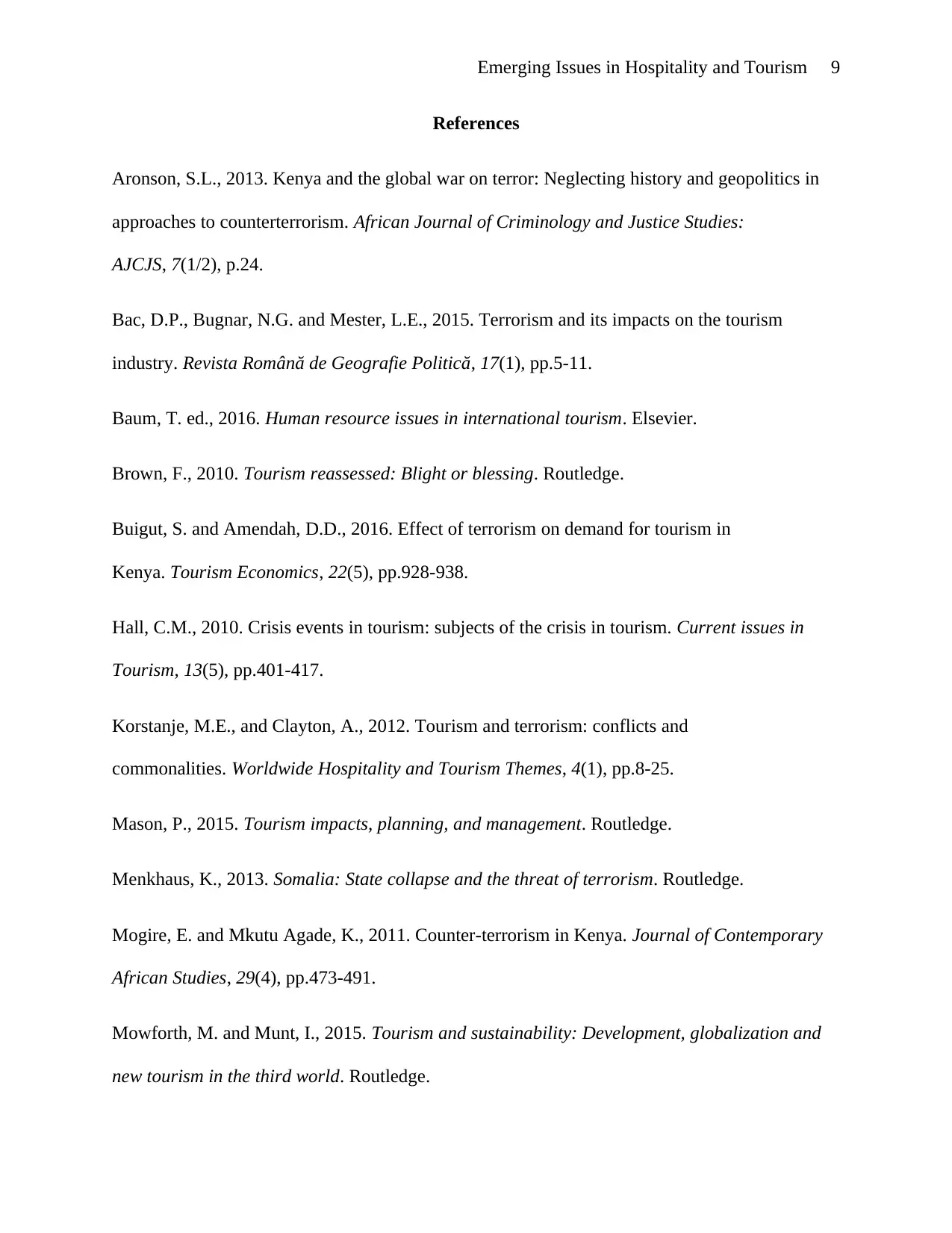
Emerging Issues in Hospitality and Tourism 9
References
Aronson, S.L., 2013. Kenya and the global war on terror: Neglecting history and geopolitics in
approaches to counterterrorism. African Journal of Criminology and Justice Studies:
AJCJS, 7(1/2), p.24.
Bac, D.P., Bugnar, N.G. and Mester, L.E., 2015. Terrorism and its impacts on the tourism
industry. Revista Română de Geografie Politică, 17(1), pp.5-11.
Baum, T. ed., 2016. Human resource issues in international tourism. Elsevier.
Brown, F., 2010. Tourism reassessed: Blight or blessing. Routledge.
Buigut, S. and Amendah, D.D., 2016. Effect of terrorism on demand for tourism in
Kenya. Tourism Economics, 22(5), pp.928-938.
Hall, C.M., 2010. Crisis events in tourism: subjects of the crisis in tourism. Current issues in
Tourism, 13(5), pp.401-417.
Korstanje, M.E., and Clayton, A., 2012. Tourism and terrorism: conflicts and
commonalities. Worldwide Hospitality and Tourism Themes, 4(1), pp.8-25.
Mason, P., 2015. Tourism impacts, planning, and management. Routledge.
Menkhaus, K., 2013. Somalia: State collapse and the threat of terrorism. Routledge.
Mogire, E. and Mkutu Agade, K., 2011. Counter-terrorism in Kenya. Journal of Contemporary
African Studies, 29(4), pp.473-491.
Mowforth, M. and Munt, I., 2015. Tourism and sustainability: Development, globalization and
new tourism in the third world. Routledge.
References
Aronson, S.L., 2013. Kenya and the global war on terror: Neglecting history and geopolitics in
approaches to counterterrorism. African Journal of Criminology and Justice Studies:
AJCJS, 7(1/2), p.24.
Bac, D.P., Bugnar, N.G. and Mester, L.E., 2015. Terrorism and its impacts on the tourism
industry. Revista Română de Geografie Politică, 17(1), pp.5-11.
Baum, T. ed., 2016. Human resource issues in international tourism. Elsevier.
Brown, F., 2010. Tourism reassessed: Blight or blessing. Routledge.
Buigut, S. and Amendah, D.D., 2016. Effect of terrorism on demand for tourism in
Kenya. Tourism Economics, 22(5), pp.928-938.
Hall, C.M., 2010. Crisis events in tourism: subjects of the crisis in tourism. Current issues in
Tourism, 13(5), pp.401-417.
Korstanje, M.E., and Clayton, A., 2012. Tourism and terrorism: conflicts and
commonalities. Worldwide Hospitality and Tourism Themes, 4(1), pp.8-25.
Mason, P., 2015. Tourism impacts, planning, and management. Routledge.
Menkhaus, K., 2013. Somalia: State collapse and the threat of terrorism. Routledge.
Mogire, E. and Mkutu Agade, K., 2011. Counter-terrorism in Kenya. Journal of Contemporary
African Studies, 29(4), pp.473-491.
Mowforth, M. and Munt, I., 2015. Tourism and sustainability: Development, globalization and
new tourism in the third world. Routledge.
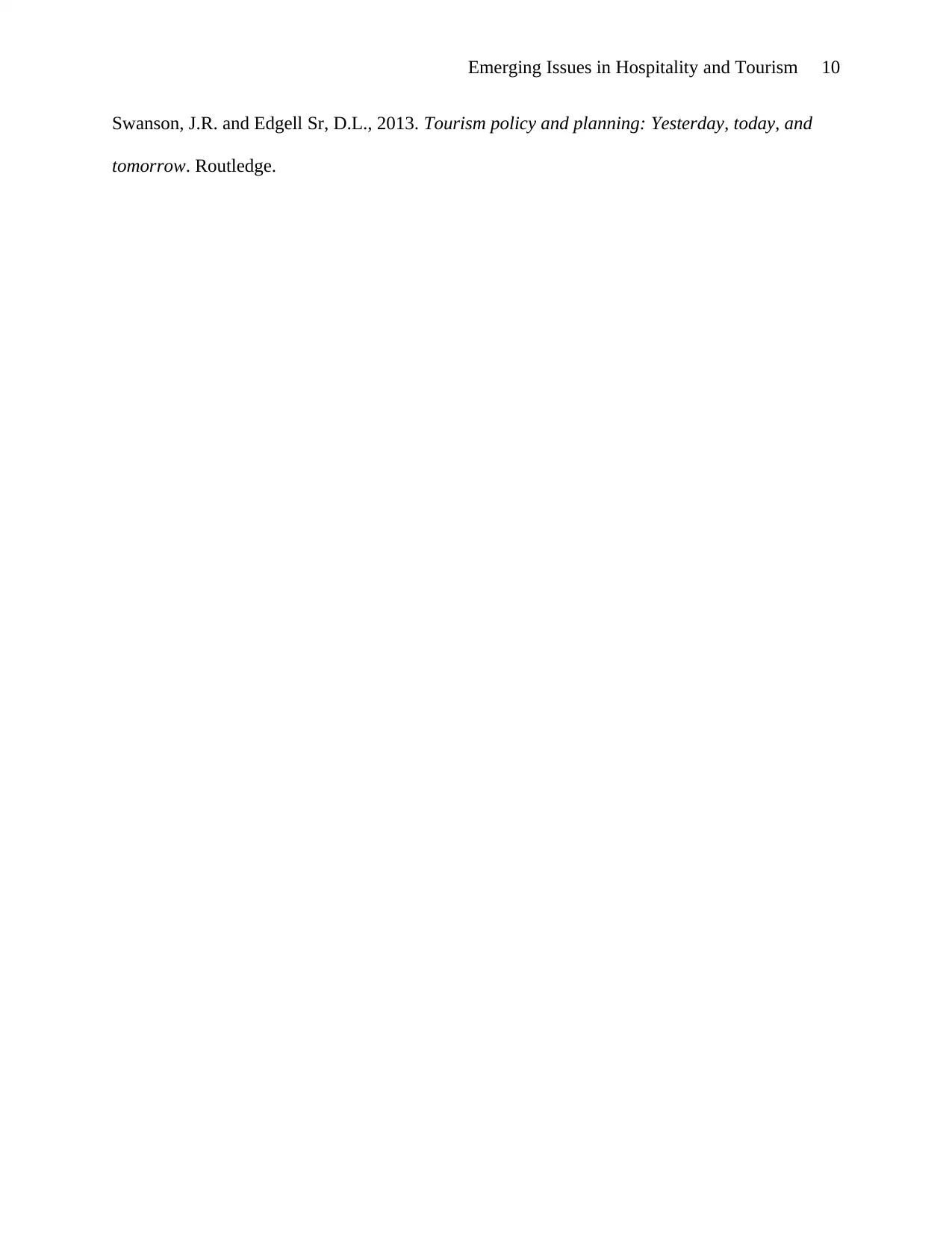
Emerging Issues in Hospitality and Tourism 10
Swanson, J.R. and Edgell Sr, D.L., 2013. Tourism policy and planning: Yesterday, today, and
tomorrow. Routledge.
Swanson, J.R. and Edgell Sr, D.L., 2013. Tourism policy and planning: Yesterday, today, and
tomorrow. Routledge.
1 out of 10
Your All-in-One AI-Powered Toolkit for Academic Success.
+13062052269
info@desklib.com
Available 24*7 on WhatsApp / Email
![[object Object]](/_next/static/media/star-bottom.7253800d.svg)
Unlock your academic potential
© 2024 | Zucol Services PVT LTD | All rights reserved.

